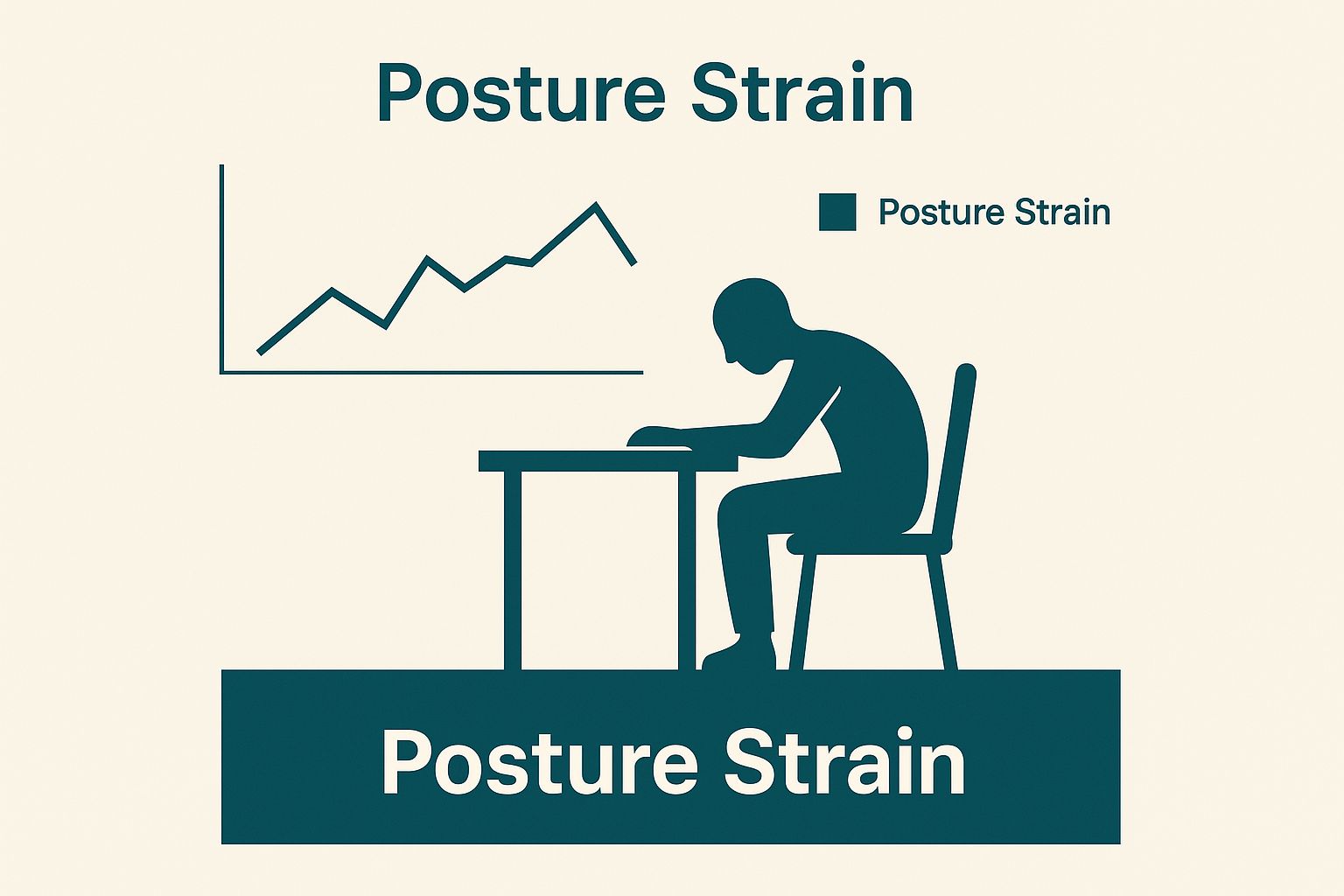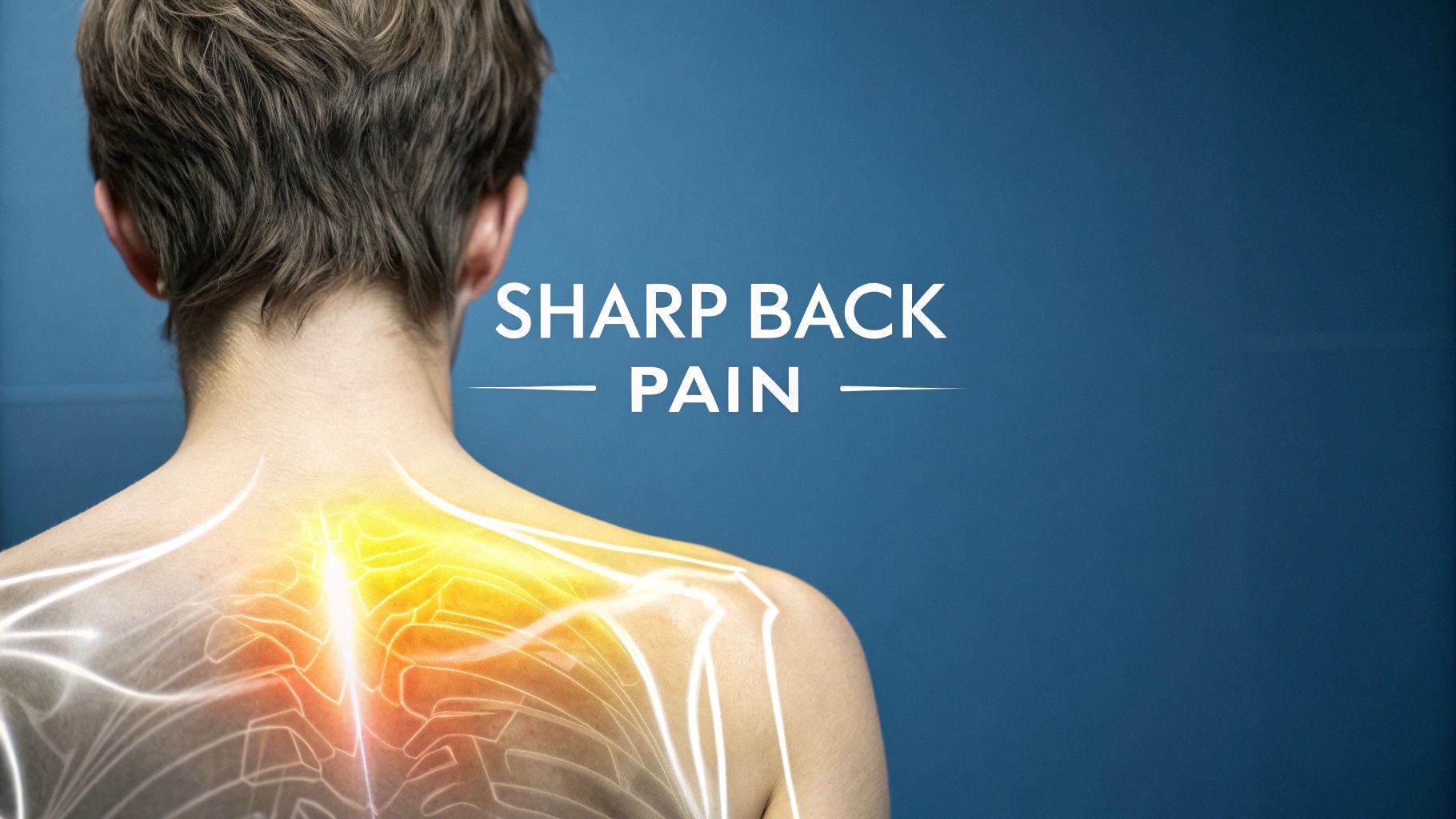.webp)
That sudden, sharp pain between your shoulder blades. It’s more than just a nuisance; it’s the kind of thing that makes you stop what you’re doing and worry.
More often than not, a sharp pain between the shoulder blades comes down to everyday life—things like muscle strain, poor posture from hours at a desk, or even just sleeping awkwardly. It feels alarming, but the culprit is usually muscular and not a sign of anything more serious.
When you feel that sharp, pinching pain, it's easy for your mind to jump to the worst-case scenario. But let's break it down. The area between your shoulder blades, known as the interscapular region, is a complex hub of muscles, nerves, and bones.
Think of it as a busy junction for your upper body. When one part gets overloaded or irritated, everything else feels the impact. This intricate setup is precisely why the area is so prone to aches and pains from relatively small triggers.
The feeling is often a deep, nagging ache that suddenly spikes into a sharp stab, especially when you turn your head or reach for something. It can feel like a stubborn knot that just won't release. This happens because the muscles holding up your head and supporting your arms are working all day long. A sudden awkward twist or prolonged tension can easily push them over the edge.
We’ll dive deeper into the causes later, but it’s helpful to know that the most common triggers are usually well within your control.
At its core, this pain is a message. It's your body's way of telling you that something—your posture, your movement habits, or even your stress levels—needs to change.
This guide is here to help you turn that worry into action. By understanding the basics of your upper back, pinpointing the common triggers, and learning what actually works for relief, you can build a solid plan. We’ll cover everything from simple home remedies and preventative exercises to recognising those rare but important red flags that mean it's time to see a doctor.
The goal isn't just to get rid of the pain now, but to give you the knowledge to keep it from coming back.

To really get to grips with that sharp pain between your shoulder blades, it helps to understand what’s going on just beneath the skin. Your upper back isn't just a flat surface; it's a wonderfully complex and dynamic system of bones, muscles, and nerves that supports almost every move your upper body makes.
When everything is working in harmony, you barely even notice it’s there. But the moment one component is strained or aggravated, the whole structure can send out loud, clear pain signals. Let's meet the key players.
Running down the centre of your upper back is the thoracic spine. This part of your spinal column starts at the base of your neck and extends down to your abdomen, made up of 12 vertebrae. Think of it as the main scaffolding that anchors everything else and provides stability.
Each of these vertebrae connects to a pair of ribs, forming your protective rib cage. Because its main job is to protect your vital organs, this area is built for stability, not flexibility. If the small joints connecting these vertebrae become stiff or misaligned, it can be a direct cause of discomfort, including that sharp ache between your shoulders.
Draped over your neck, shoulders, and upper back like a large, diamond-shaped shawl is the trapezius muscle, or "traps" for short. This is the muscle that lets you move your head, neck, and shoulder blades.
It's divided into three parts: upper, middle, and lower. The middle fibres, which run horizontally, are responsible for pulling your shoulder blades together. When you slouch or carry tension from stress, these fibres can get overworked and develop painful trigger points—those tight "knots" that can refer sharp pain right into the space between your shoulder blades.
The complex network of muscles, bones, and nerves in the upper back means that the source of your pain is often interconnected. A problem in one area, such as neck strain, can easily manifest as a sharp pain between the shoulders.
Tucked away underneath the trapezius are the rhomboid muscles. These smaller but crucial muscles act like ropes, connecting the inside edges of your shoulder blades to your spine. Their main job is to pull your shoulder blades back towards the centre.
If you spend hours hunched over a desk or staring down at your phone, your rhomboids are forced into a constantly stretched, weakened position. This chronic strain often leads to inflammation and micro-tears, causing that familiar, intense ache deep in your upper back. More often than not, this is the main culprit when the pain feels like it's right next to your spine.
Seeing how these parts work together makes it clear why a seemingly simple habit like slouching can have such painful results. When one part of the system is out of balance, the others have to compensate, creating a domino effect of strain and discomfort. For more detailed information on causes and treatments, our patient resources on back pain can provide further valuable insights.
That sharp, stabbing pain between your shoulder blades rarely appears out of thin air. More often than not, it’s the final straw after a specific activity, habit, or posture has pushed your upper back too far. The vast majority of these issues stem from the musculoskeletal system—the complex web of muscles, bones, and tendons holding you upright.
Getting to the root of these common triggers is the first step towards getting rid of the pain for good.
One of the most common culprits is a simple muscle strain. This is what happens when you ask your muscles to do more than they’re ready for, especially the rhomboid and trapezius muscles which are prime candidates for this kind of sharp, sudden injury.
Think of the classic "weekend warrior" who spends all Saturday lifting heavy boxes in the garage. Or the person who goes a bit too hard on the rowing machine at the gym with less-than-perfect form. These actions can create tiny micro-tears in the muscle fibres, leading to that immediate, sharp pain and stiffness that follows.
In a world dominated by screens, poor posture has become an epidemic. Slouching over a laptop, craning your neck down to scroll through your phone, or sinking into the sofa for hours on end puts a constant, low-level strain on the muscles between your shoulder blades.
This sustained bad posture forces some muscles, like your rhomboids, into a stretched-out, weakened state. Meanwhile, others, like your upper traps, become overworked and tight. Over time, this imbalance creates fatigue, inflammation, and that familiar dull ache that can suddenly turn sharp with the smallest movement. It’s no wonder they call it 'tech neck'.

This image perfectly illustrates how an everyday activity like sitting at a desk can directly fuel the muscular imbalances that trigger shoulder blade pain.
Sometimes, the pain isn’t a general ache but a very specific, intensely sore spot—a "knot" that’s tender when you press on it. This is a myofascial trigger point. These are small, hyperirritable spots locked within a tight band of muscle that can send pain shooting to other areas.
Trigger points are like tiny muscle cramps that just won't let go. Pushing on one can cause a sharp, radiating pain that travels away from the knot itself, often landing right between the shoulder blades.
These knots can pop up from a single injury but more often develop from repetitive strain or chronic muscle tension. Think of a new parent who constantly carries their baby on one hip; this uneven load is a perfect recipe for developing trigger points in the upper back. Understanding these origins is a key part of effectively treating musculoskeletal pain.
The reality is, this kind of discomfort is incredibly common. In the UK, musculoskeletal conditions are a leading cause of disability. In fact, data shows around 84% of people with chronic pain report problems in their neck or shoulder region, which can seriously affect their daily lives.
To help you tell the difference between these common culprits, here’s a quick breakdown.
This table breaks down the typical symptoms, primary triggers, and characteristics of the most common musculoskeletal causes of sharp pain between the shoulder blades.
While each has its own signature feel, knowing what you're up against makes finding the right relief strategy much easier.
While most cases of sharp pain between the shoulder blades are down to muscle strain, it pays to know when it might be flagging something more serious. Think of this pain like a fire alarm – most of the time it’s just a bit of toast you’ve burnt, but you still need to know how to recognise a real fire.
This isn’t about causing panic over everyday aches. It’s about empowering you to act decisively when it truly matters.
Sometimes, the pain you feel in your upper back isn't coming from your back at all. This is called referred pain, a classic case of crossed wires in the body's nervous system. A problem with an internal organ can send pain signals along shared nerve pathways, and your brain misinterprets them as coming from your shoulder blades.
So, how do you tell the difference between a simple pulled muscle and something more urgent? It often comes down to the other symptoms tagging along for the ride.
A garden-variety muscle strain typically feels worse when you move a certain way and gets better with a bit of rest. Referred pain, on the other hand, often sticks around, a constant, nagging ache that doesn’t care whether you’re sitting, standing, or stretching.
Keep a close eye out for these additional signs that suggest the pain is not just muscular:
These symptoms are important clues that help you and your doctor look beyond the obvious.
Although it's rare, a sharp pain between the shoulder blades can sometimes be a sign of a serious condition that needs immediate medical attention.
Cardiac EventsA heart attack doesn't always present as the classic "clutching the chest" scenario, especially in women. The pain can show up as a sudden, severe ache between the shoulder blades, sometimes described as a tearing or ripping feeling. This is particularly true for an aortic dissection, a life-threatening tear in the body's main artery.
If your shoulder blade pain is sudden, severe, and comes with shortness of breath, pain in your jaw or arm, dizziness, or nausea, you should seek emergency medical help immediately.
It’s worth getting familiar with all the signs of serious chest pain to know when urgent care is needed.
Gallbladder IssuesAn inflamed gallbladder, often due to gallstones, can cause an intense pain that radiates to the right shoulder blade. This pain often flares up after a fatty meal and might be joined by nausea, vomiting, and a fever.
Herniated DiscWhile it sounds like a back problem, a herniated disc in the neck (cervical spine) or upper back (thoracic spine) is much more serious than a simple strain. If a disc bulges and presses on a nerve root, it can send a sharp, electric shock-like pain into the area between your shoulders. Numbness, tingling, or weakness in your arms or hands often comes with it.
Shoulder and upper back pain is a common complaint in the United Kingdom, affecting roughly 2.4% of adults aged 18 to 60 who see their GPs each year. While that might seem like a small fraction, the numbers are on the rise, with women reporting this type of pain more frequently than men.

When that sharp, nagging pain between your shoulder blades hits, the first thing on your mind is, "How do I make this stop?" The good news is that a smart combination of immediate at-home care and, when needed, professional guidance can make a world of difference. Think of this as your roadmap to managing the discomfort and getting back to feeling good.
We’ll start with simple, powerful strategies you can use right away. These first steps are all about calming inflammation, soothing those wound-up muscles, and gently getting things moving again—tackling the most common culprits behind interscapular pain.
Often, your first line of defence is right there in your own home. These simple techniques can take the edge off a sharp pain between your shoulder blades, especially when it’s down to a muscle issue.
1. Strategic Use of Heat and Cold
Think of heat and cold as two different tools for two different jobs. If you've just strained a muscle or the pain is new and sharp, a cold pack (or even a bag of frozen peas wrapped in a tea towel) for 15-20 minutes is your best bet. The cold helps dial down inflammation, particularly within the first 48 hours of an injury.
On the other hand, for that deep, persistent ache or chronic muscle tightness, a warm compress or heating pad is fantastic. Heat boosts blood flow, which helps tight muscles relax and eases stiffness. Sometimes, alternating between the two can give you the best of both worlds.
2. Gentle Stretching and Mobility
It might feel like the last thing you want to do, but gentle movement is often the key to relief. Staying completely still can actually make stiffness worse. The idea isn't to push through sharp pain but to encourage gentle, restorative movement.
These movements should always feel controlled and comfortable. If any stretch makes the pain worse, back off immediately. The goal here is to release tension, not create more of it.
For those stubborn, deep knots that just won't let go, a few simple tools can work wonders for self-massage. A tennis ball or a foam roller can be incredibly effective for getting at the deep muscle tension causing that sharp pain.
Just place a tennis ball between your back and a wall, right on the sore spot. By leaning into it and gently rolling around, you can apply targeted pressure to release the knot. You’re in complete control of the intensity.
For many people, how you sleep plays a massive role, too. If you suspect your bed isn't helping, it might be worth looking into a complete guide to mattress toppers for back pain to create a more supportive setup.
If you’ve tried these home remedies for a week or two and the pain is still hanging around, or if it's severe or keeps coming back, it’s time to call in the professionals. A qualified practitioner can give you a proper diagnosis and create a treatment plan that gets to the root of the problem.
Choosing the right professional often depends on the exact nature of your pain, but a thorough assessment is always the first step. If you’re exploring your options, understanding the different approaches available through professional pain management services can help you make an informed decision and get on the right path to recovery.
Once you’ve finally managed to ease that nagging pain between your shoulder blades, the goal shifts. It's no longer just about relief; it's about making sure it doesn't come back.
Prevention is an active game, not a passive one. It’s built on small, consistent habits that make your body more resilient to daily stresses. Think of it as reinforcing your body's scaffolding to better handle whatever you throw at it.
This means making mindful tweaks to your posture, movement, and your environment. By tackling the root causes of muscle imbalances, you can build a stronger, more stable upper back that’s far less likely to complain.
Let's be honest: for many of us, our desk is the scene of the crime. Hours spent hunched over a keyboard put a relentless strain on the muscles between the shoulders, slowly weakening them. An ergonomic setup isn't a luxury; it's one of the most powerful preventative steps you can take.
Start with your chair. Your feet should be flat on the floor with your knees at roughly a 90-degree angle. Your monitor needs to be straight ahead, with the top of the screen at or just below eye level. This simple adjustment stops you from craning your neck down all day.
Finally, pull your keyboard and mouse in close. Your elbows should be able to rest comfortably by your sides, not reaching forward.
An ergonomic workspace isn't about buying expensive gear. It’s about arranging what you already have to support a neutral spine. The aim is to make good posture feel easy and natural.
If you’re not sure where to start, a professional ergonomic assessment can give you personalised recommendations to help create a pain-free workspace that fits you perfectly.
Your muscles are the active support crew for your spine. When you strengthen the key players in your upper back and core, you're essentially building a natural brace for your body. This provides stability and takes the pressure off weaker, overstrained areas.
Focus on the muscles you can't see in the mirror:
Integrating specific exercises designed to realign your spine and improve posture can be a game-changer, especially if your pain is rooted in long-term postural habits.
Prevention goes way beyond your desk and the gym. It's about being aware of how you move all day long.
When lifting anything heavy, forget your back. Bend at your knees and hips, keep the object hugged close to your body, and switch on your core muscles. And never, ever twist while lifting.
Set a timer on your phone to get up and move every 30-60 minutes. A quick walk around the room or a few simple stretches is all it takes to reset your posture and stop muscle fatigue from creeping in.
This becomes even more important as we get older. A review of shoulder pain in UK workers found that its prevalence shoots up with age, particularly in physically demanding jobs. It’s a stark reminder that proactive care is essential. You can read the full research about these findings if you want to dig deeper.
We get a lot of questions about that nagging, sharp pain between the shoulder blades. Here are some straightforward answers to the most common ones.
If you're dealing with a minor muscle strain, you can expect the sharpness to fade within a few days to a week, especially with good rest and some simple at-home care.
However, if the cause is a deeper strain or a long-term postural issue, it might take several weeks to resolve completely. If the pain sticks around for more than two weeks or seems to be getting worse, it's time to get it checked out by a professional.
Absolutely. When we're stressed, our bodies have a habit of tensing up, and the neck, shoulders, and upper back are prime targets. This constant muscle contraction can lead to tension, trigger points, and that all-too-familiar sharp ache between the shoulder blades.
It's amazing what a difference relaxation techniques, mindfulness, and just taking regular breaks to move around can make. These simple habits can help manage stress-related muscle pain before it becomes a chronic problem.
For most people, sleeping on your back is the winner. Placing a pillow under your knees helps maintain the natural curve of your spine, taking the strain off your back and shoulders.
If you're a dedicated side sleeper, try putting a pillow between your knees. The key is to use a pillow for your head that keeps it perfectly aligned with your spine—not tilted up or down. We generally advise against sleeping on your stomach, as it forces your neck and back into an unnatural position and often makes the pain worse.
At The Vesey, our specialists are dedicated to finding the real cause of your pain and creating a personalised plan to bring you lasting relief. To find out more about how our expert team can help, visit us at https://www.thevesey.co.uk.

